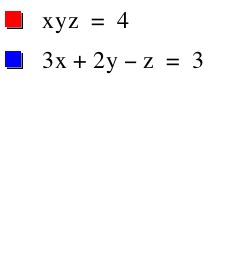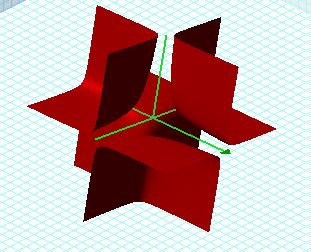

Given:

Our Task: Find as many solutions as possible that satisfy these two equations (that is to say, find values for 'a', 'b', and 'c' that makes these statements true).
One method of attacking a task like this is to simply pick some values for a, b, and/or c and determine whether they are solutions to the system of equations. Let's see . . . what happens if we let a=b=0? We know that a*b*c=4, but if 'a' and 'b' are 0 then we see that a*b*c=(0)(0)(c)=0 --- not 4. So it looks like 'a' and 'b' can not both be 0.
Well, what if a=b=1? We know that a*b*c=4 so if 'a' and 'b' are both 1, so (1)(1)(c)=4. So our only candidate for 'c' is 4. Does the point (1,1,4) also satisfy our second equation? Let's see.

So the point (1,1,4) is not a solution to our system of equations.
Try selecting other values for 'a' and 'b' and see if you can find a solution to the system of equations.
How can we check to make sure this system of equations acually has solutions? If we graph functions on the same set of axes, then the solutions of that system of equations is represented by points of intersection. So if we graphed these two equations on the same axes and they did not intersect we could conclude that they have no real solutions. Notice that each each of our two functions is written in terms of three variables. How many dimensions do you think that the graphs will be displayed in?
Check out the graph of each function below.



If we plot these on the same axes, do you think they will have any points of intersections? Why?
Here we go . . .


Ah hah! These two functions do intersect. This can only mean one thing . . . we do have some solutions to find. Question: How many solutions exist?
Let's take a second and look back at our equations.

If we could eliminate one variable, then our task would be quite a bit easier. Any ideas about how to do this? There are many different methods we could use . . . how about solving each equation for the same variable. In this case, solving for 'c' might be the most simple task. So we see

From this we can conclude that

Now, values of 'a' and 'b' which make this equation true are candidates for solutions to our original system of equations. We can simply use these 'a' and 'b' values to solve for 'c' [c=4/(ab)] and we have a solution (a,b,c) for our system of equations.
Let's check out a graph of this equation.

Very interesting . . . not something we usually come across.
So, how exactly does this graph relate to our original 3 dimensional picture? Let's look at them side by side.


By eliminating the 'c' variable (which is plotted on the z-axis) we have essentially squashed (that is, projected) the points of intersection down onto the ab-plane (normally the xy-plane). Take a moment and compare the 3 dimensional graph to the 'squashed' 2 dimensional graphs. How are they similar? How are they different?
Look back at the 2 dimensional graph below. What do you notice about points on this graph. What does this mean about 'a' and 'b' values for solutions to our system of equations?

This function does not have any points in the third quadrant, where 'a' and 'b' would both be negative. Does this seem to fit with our initial equations?

If 'a' and 'b' are both negative then using the fact that a*b*c=4, it must be the case that 'c' is positive. So we know that 'a' and 'b' are negative and 'c' is positive. Thus 3a, 2b, and -c are negative so the sum of these must also be negative. But we know that 3a+2b-c=3 and 3 is not negative. Therefore it is impossible for both 'a' and 'b' to be negative.
Our final question, how many solutions do we
end up with? Each point in our projected graph, represents one
solution to our system of equations (recall that we only have
to solve for 'c'). And their are infinitely many points on the
graph of ![]() , this means that there are infinitely
many solutions to our system of equations.
, this means that there are infinitely
many solutions to our system of equations.
Given:

Question: What are solutions to this system of equations (if any actually exist)? How can you find them?
Use this Graphing Calculator file to look at the graphs of these functions. Then eliminate one of the variables (as we did before) and graph the resulting 2 dimensional graph. Do you notice anything about where the solution of the system exist? How do the solutions change when the constants (1 and 4) change?